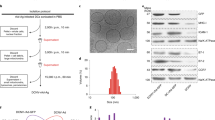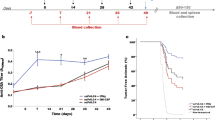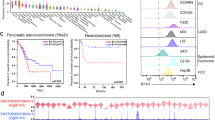Abstract
Soluble B7.1/IgG Fc fusion protein, which has costimulatory effects, is an effective molecular adjuvant in tumor immune therapy. Here, we describe a nonviral intramuscular (i.m.) gene transfer method to deliver this therapeutic protein. Gene transfer was greatly enhanced by electroporation and highly efficient production of this protein was achieved. Serum levels reached up to 1 μg/ml with considerable length of expression and without apparent systemic adverse effects. Lymphocytes from mice coinjected with soluble B7.1/IgG1 and carcinoembryonic antigen (CEA)-encoding plasmids showed significantly elevated CEA-stimulated proliferation, cytokine production, and cytotoxic T-lymphocyte (CTL) activity. These mice gained significant protection against a CEA-positive transplanted tumor, in terms of reduced tumor incidence and growth. The effects were superior when soluble B7.1/IgG1 was expressed as compared to membrane-bound wild-type B7.1. Notably, expression of soluble B7.1/IgG1 alone did not induce any protection against tumor, confirming its primary role as a costimulatory molecule rather than a direct antitumor agent. The plasmid encoding B7.1/IgG1 did not have to be injected at the same site as the antigen-encoding plasmid to exert its adjuvant effect, indicating that circulating protein was sufficient. Muscle histopathology revealed minimal damage to DNA-injected muscles. Importantly, we show that, after gene transfer, muscle tissue can produce this protein in large quantity to exert its immune costimulatory effect for cancer therapy and it would be otherwise difficult and expensive to maintain this high a level of recombinant protein.
This is a preview of subscription content, access via your institution
Access options
Subscribe to this journal
Receive 12 print issues and online access
$259.00 per year
only $21.58 per issue
Buy this article
- Purchase on Springer Link
- Instant access to full article PDF
Prices may be subject to local taxes which are calculated during checkout








Similar content being viewed by others
References
Prud'homme GJ, Lawson BR, Chang Y, Theofilopoulos AN . Immunotherapeutic gene transfer into muscle. Trends Immunol. 2001;22:149–155.
Prud'homme GJ, Chang Y . Prevention of autoimmune diabetes by intramuscular gene therapy with a nonviral vector encoding an interferon-gamma receptor/IgG1 fusion protein. Gene Ther. 1999;6:771–777.
Lawson BR, Prud'homme GJ, Chang Y, et al. Treatment of murine lupus with cDNA encoding IFN-gammaR/Fc. J Clin Invest. 2000;106:207–215.
Mir LM, Bureau MF, Gehl J, et al. High-efficiency gene transfer into skeletal muscle mediated by electric pulses. Proc Natl Acad Sci USA. 1999;96:4262–4267.
Mathiesen I . Electropermeabilization of skeletal muscle enhances gene transfer in vivo. Gene Ther. 1999;6:508–514.
Song K, Chang Y, Prud'homme GJ . IL-12 plasmid-enhanced DNA vaccination against carcinoembryonic antigen (CEA) studied in immune-gene knockout mice. Gene Ther. 2000;7:1527–1535.
Song K, Chang Y, Prud'homme GJ . Regulation of T-helper-1 versus T-helper-2 activity and enhancement of tumor immunity by combined DNA-based vaccination and nonviral cytokine gene transfer. Gene Ther. 2000;7:481–492.
Prud'homme GJ . Gene therapy of autoimmune diseases with vectors encoding regulatory cytokines or inflammatory cytokine inhibitors. J Gene Med. 2000;2:222–232.
Coyle AJ, Gutierrez-Ramos JC . The expanding B7 superfamily: increasing complexity in costimulatory signals regulating T cell function. Nat Immunol. 2001;2:203–209.
Leach DR, Krummel MF, Allison JP . Enhancement of antitumor immunity by CTLA-4 blockade. Science. 1996;271:1734–1736.
Swiniarski H, Sturmhoefel K, Lee K, et al. Immune response enhancement by in vivo administration of B7.2Ig, a soluble costimulatory protein. Clin Immunol. 1999;92:235–245.
Pardoll DM . Cancer vaccines. Nat Med. 1998;4:525–531.
Moro M, Gasparri AM, Pagano S, et al. Induction of therapeutic T-cell immunity by tumor targeting with soluble recombinant B7-immunoglobulin costimulatory molecules. Cancer Res. 1999;59:2650–2656.
Sturmhoefel K, Lee K, Gray GS, et al. Potent activity of soluble B7–IgG fusion proteins in therapy of established tumors and as vaccine adjuvant. Cancer Res. 1999;59:4964–4972.
Todo T, Martuza RL, Dallman MJ, Rabkin SD . In situ expression of soluble B7-1 in the context of oncolytic herpes simplex virus induces potent antitumor immunity. Cancer Res. 2001;61:153–161.
Hartikka J, Sawdey M, Cornefert-Jensen F, et al. An improved plasmid DNA expression vector for direct injection into skeletal muscle. Hum Gene Ther. 1996;7:1205–1217.
Chang Y, Prud'homme GJ . Intramuscular administration of expression plasmids encoding interferon-gamma receptor/IgG1 or IL-4/IgG1 chimeric proteins protects from autoimmunity. J Gene Med. 1999;1:415–423.
Kass E, Schlom J, Thompson J, Guadagni F, Graziano P, Greiner JW . Induction of protective host immunity to carcinoembryonic antigen (CEA), a self-antigen in CEA transgenic mice, by immunizing with a recombinant vaccinia-CEA virus. Cancer Res. 1999;59:676–683.
Manthorpe M, Cornefert-Jensen F, Hartikka J, et al. Gene therapy by intramuscular injection of plasmid DNA: studies on firefly luciferase gene expression in mice. Hum Gene Ther. 1993;4:419–431.
Fields PE, Finch RJ, Gray GS, et al. B7.1 is a quantitatively stronger costimulus than B7.2 in the activation of naive CD8+ TCR-transgenic T cells. J Immunol. 1998;161:5268–5275.
Gajewski TF . B7-1 but not B7-2 efficiently costimulates CD8+ T lymphocytes in the P815 tumor system in vitro. J Immunol. 1996;156:465–472.
Gajewski TF, Fallarino F, Uyttenhove C, Boon T . Tumor rejection requires a CTLA4 ligand provided by the host or expressed on the tumor: superiority of B7-1 over B7-2 for active tumor immunization. J Immunol. 1996;156:2909–2917.
Geldhof AB, Raes G, Bakkus M, Devos S, Thielemans K, De Baetselier P . Expression of B7-1 by highly metastatic mouse T lymphomas induces optimal natural killer cell-mediated cytotoxicity. Cancer Res. 1995;55:2730–2733.
Yeh KY, Pulaski BA, Woods ML, et al. B7-1 enhances natural killer cell-mediated cytotoxicity and inhibits tumor growth of a poorly immunogenic murine carcinoma. Cell Immunol. 1995;165:217–224.
Ravetch JV, Bolland S . IgG Fc receptors. Annu Rev Immunol. 2001;19:275–290.
Sharpe AH, Freeman GJ . The B7-CD28 superfamily. Nat Rev Immunol. 2002;2:116–126.
Salomon B, Bluestone JA . Complexities of CD28/B7: CTLA-4 costimulatory pathways in autoimmunity and transplantation. Annu Rev Immunol. 2001;19:225–252.
Zhou H, Sequeira M, Goad ME, et al. Efficacy and mechanisms of action of rmB7.2-Ig as an antitumor agent in combination with Adriamycin and Cytoxan chemotherapy. Clin Immunol. 2001;101:303–314.
Stamper CC, Zhang Y, Tobin JF, et al. Crystal structure of the B7-1/CTLA-4 complex that inhibits human immune responses. Nature. 2001;410:608–611.
Zheng P, Wu Y, Guo Y, Lee C, Liu Y . B7-CTLA4 interaction enhances both production of antitumor cytotoxic T lymphocytes and resistance to tumor challenge. Proc Natl Acad Sci USA. 1998;95:6284–6289.
Chambers CA, Kuhns MS, Egen JG, Allison JP . CTLA-4-mediated inhibition in regulation of T cell responses: mechanisms and manipulation in tumor immunotherapy. Annu Rev Immunol. 2001;19:565–594.
Ravetch JV, Bolland S . IgG Fc receptors. Annu Rev Immunol. 2001;19:275–290.
Cho JH, Youn JW, Sung YC . Cross-priming as a predominant mechanism for inducing CD8(+) T cell responses in gene gun DNA immunization. J Immunol. 2001;167:5549–5557.
Corr M, von Damm A, Lee DJ, Tighe H . In vivo priming by DNA injection occurs predominantly by antigen transfer. J Immunol. 1999;163:4721–4727.
Heath WR, Carbone FR . Cross-presentation, dendritic cells, tolerance and immunity. Annu Rev Immunol. 2001;19:47–64.
Carpenter S, Karpati G . Centronuclear and myotubular myopathies. In: Carpenter S. and Karpati G. Pathology of Skeletal Muscle. 2nd edn. New York: Oxford University Press, Inc.; 2001; 382–393.
Ilantzis C, DeMarte L, Screaton RA, Stanners CP . Deregulated expression of the human tumor marker CEA and CEA family member CEACAM6 disrupts tissue architecture and blocks colonocyte differentiation. Neoplasia. 2002;4:151–163.
Ordonez C, Screaton RA, Ilantzis C, Stanners CP . Human carcinoembryonic antigen functions as a general inhibitor of anoikis. Cancer Res. 2000;60:3419–3424.
Acknowledgements
This study was funded by the National Cancer Institute of Canada (NCIC). Zheng F Zhou is a recipient of a postgraduate scholarship from the Natural Science and Engineering Research Council of Canada (NSERC). We thank Dr Fawaz Halwani for assistance with FACS analyses, and Dr Keli Song for helpful advice during the course of this study. We also thank Dr Abraham Fuks (McGill University, Canada) for kindly providing reagents and the B18 hybridoma cell line.
Author information
Authors and Affiliations
Corresponding author
Rights and permissions
About this article
Cite this article
Zhou, Z., Peretz, Y., Chang, Y. et al. Intramuscular gene transfer of soluble B7.1/IgG1 fusion cDNA induces potent antitumor immunity as an adjuvant for DNA vaccination. Cancer Gene Ther 10, 491–499 (2003). https://doi.org/10.1038/sj.cgt.7700595
Received:
Published:
Issue Date:
DOI: https://doi.org/10.1038/sj.cgt.7700595
Keywords
This article is cited by
-
Soluble immune checkpoints in cancer: production, function and biological significance
Journal for ImmunoTherapy of Cancer (2018)



